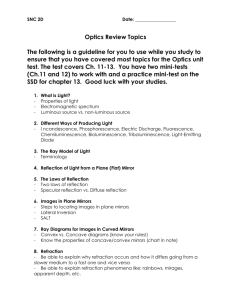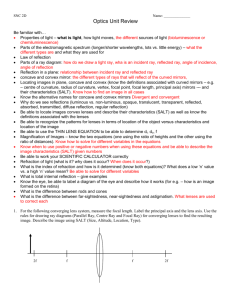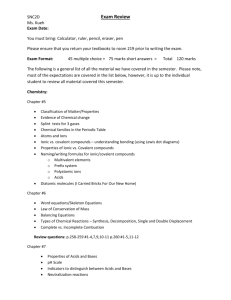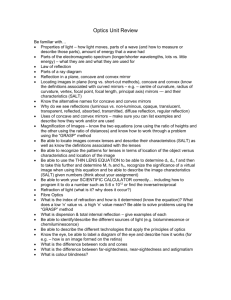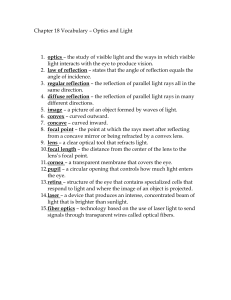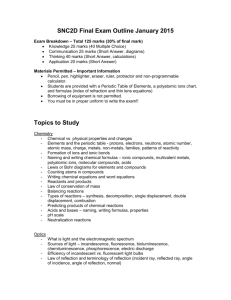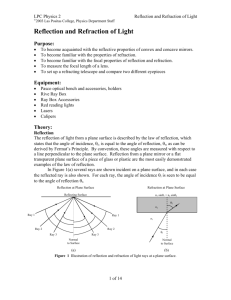Science 8 “Optics”
advertisement
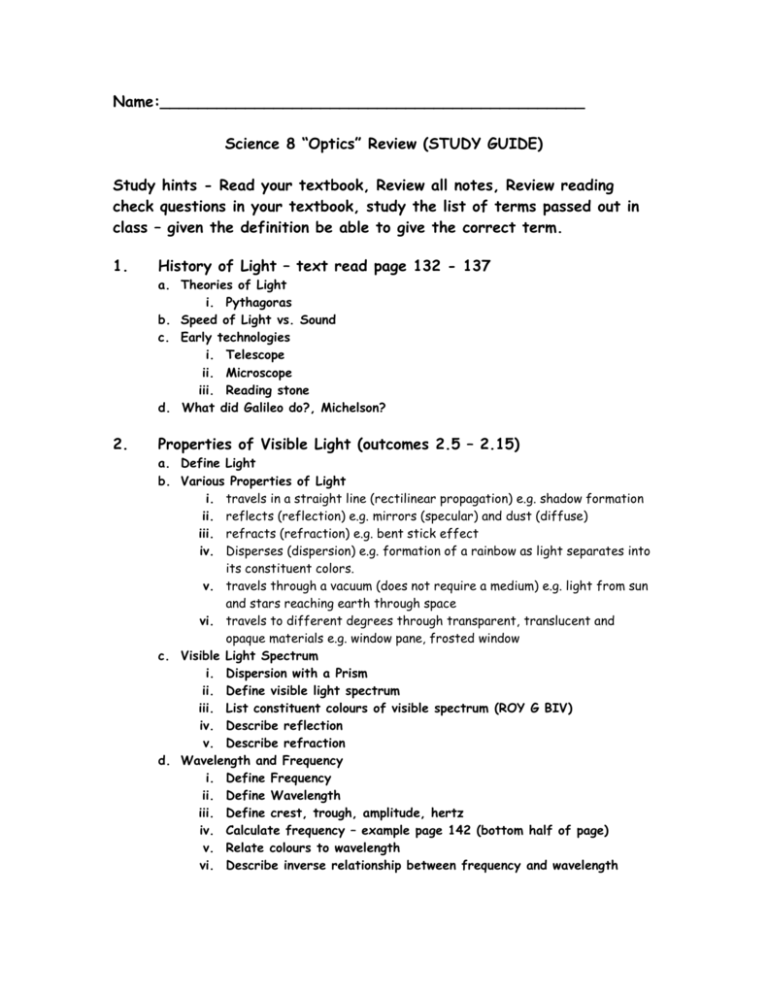
Name:_____________________________________________ Science 8 “Optics” Review (STUDY GUIDE) Study hints - Read your textbook, Review all notes, Review reading check questions in your textbook, study the list of terms passed out in class – given the definition be able to give the correct term. 1. History of Light – text read page 132 - 137 a. Theories of Light i. Pythagoras b. Speed of Light vs. Sound c. Early technologies i. Telescope ii. Microscope iii. Reading stone d. What did Galileo do?, Michelson? 2. Properties of Visible Light (outcomes 2.5 – 2.15) a. Define Light b. Various Properties of Light i. travels in a straight line (rectilinear propagation) e.g. shadow formation ii. reflects (reflection) e.g. mirrors (specular) and dust (diffuse) iii. refracts (refraction) e.g. bent stick effect iv. Disperses (dispersion) e.g. formation of a rainbow as light separates into its constituent colors. v. travels through a vacuum (does not require a medium) e.g. light from sun and stars reaching earth through space vi. travels to different degrees through transparent, translucent and opaque materials e.g. window pane, frosted window c. Visible Light Spectrum i. Dispersion with a Prism ii. Define visible light spectrum iii. List constituent colours of visible spectrum (ROY G BIV) iv. Describe reflection v. Describe refraction d. Wavelength and Frequency i. Define Frequency ii. Define Wavelength iii. Define crest, trough, amplitude, hertz iv. Calculate frequency – example page 142 (bottom half of page) v. Relate colours to wavelength vi. Describe inverse relationship between frequency and wavelength 3. Electromagnetic Radiation and Spectrum ( outcomes 2.16 – 2.22)Read page 156 – 167 in your textbook) a. Describe and provide examples of the electromagnetic spectrum i. radio waves (telecommunications) ii. microwaves (cooking food) iii. infrared (motion sensors) iv. visible light v. ultraviolet (sun tanning) vi. x-rays (medical detection) vii. gamma rays (kills cancer cells) b. Differentiate between Visible Light Spectrum and Electromagnetic Spectrum c. Describe possible positive and negative effects of X-rays,UV rays and Gamma rays 4. Reflection ( Outcomes 2.23 – 2.51) a. Describe Reflection (Definitions for incidence, reflection and normal.) Define and be able to label on a diagram i. incident light ray ii. reflected light ray iii. normal iv. angle of incidence v. angle of reflection b. Differentiate between specular and diffuse reflection.( which one helps you read a book?) c. State the Laws of Reflection d. Ray Diagrams i. Construct Ray Diagrams to describe the image formed in a plane mirror. ii. Use SPOT (size, position, orientation, type) to describe image properties. e. Plane Mirrors( example - bathroom mirror) f. Concave Mirrors(example - inside of metal spoon) i. Define focal point, focal length and the principal axis. ii. Construct ray diagrams to describe the image properties (SPOT) in concave mirrors (object between focal point and mirror • object between focal point and 2x focal length • object beyond 2x focal length) iii. Define real image and virtual image g. Convex Mirrors (example - safety mirror on bus) i. Construct ray diagrams to describe the image properties (SPOT) in convex mirrors. h. Optical devices using mirrors. i. Example is a periscope 5. Refraction (Outcomes 2.52 – 2.69) a. Identify examples of refraction (bent stick effect) b. Describe how light is refracted (qualitatively) c. Define: i. incident ray ii. refracted ray iii. angle of incidence iv. angle of refraction d. Use concept of medium/density to describe how speed of light changes causing refraction. e. Angles of Incidence and Refraction – how do they change with different mediums? (example air versus water?) f. Convex Lenses (example - magnifying glass, eyeglasses) i. Define concave lens, focal length of a lens ii. Sketch a convex lens iii. Why does a lens have a focal point on both sides? iv. Define optical center. Label on a diagram. Describe how incident rays refract through convex lenses. iii. Construct ray diagrams to describe the image properties (SPOT) in a double convex lens, when the object’s distance changes. g. Concave Lenses (example - eyeglasses) -Construct ray diagrams to describe the image properties (SPOT) in a double concave lens, when the object’s distance changes -Sketch a concave lens -Define concave lens 6. Optical technologies (Outcomes 2.70 – 2.72) a. Describe examples optical technologies i. telescopes ii. microscopes b. Know about “Fibre Optics”

